Overview of Carbide Buttons
Carbide buttons are small yet mighty components, crucial in the drilling and mining industries. These tiny powerhouses are made from tungsten carbide, a compound that marries tungsten with carbon to create one of the hardest materials known to man. But what makes these little buttons so vital, and how do you choose the right one? This guide will walk you through everything you need to know about carbide buttons—from their types and applications to their material properties and how to select the perfect fit for your needs.
What Exactly Are Carbide Buttons?
Imagine trying to drill through rock or other extremely hard materials. Traditional steel tools might crumble under the pressure, but carbide buttons step up to the challenge. Their extreme hardness and resistance to wear make them ideal for cutting, grinding, and drilling. But that’s just scratching the surface.
These buttons are used in various tools like drilling bits, saws, and even in specialized equipment for industrial applications. They come in multiple shapes, sizes, and compositions, tailored for specific tasks. Let’s dive deeper into the world of carbide buttons and discover what makes them tick.
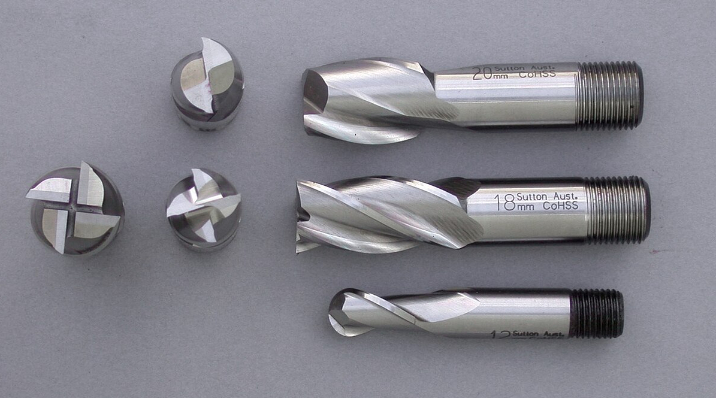
Types of Carbide Buttons
When choosing a carbide button, understanding the types available is crucial. Below is a descriptive table that outlines some common types of carbide buttons, along with their specific uses and properties.
| Type of Carbide Button | Description | Application |
|---|---|---|
| Conical Buttons | Feature a pointed tip, ideal for cutting and drilling hard materials. | Used in mining, tunneling, and construction industries. |
| Spherical Buttons | Rounded shape, providing high resistance to wear. | Suitable for high-impact drilling applications. |
| Chisel Buttons | Chisel-like shape, perfect for cutting through softer materials. | Commonly used in wood and plastic industries. |
| Parabolic Buttons | Parabolic shape, designed for optimal energy distribution during drilling. | Used in deep drilling operations, especially in oil fields. |
| Flat Buttons | Flat-topped, ideal for grinding and polishing tasks. | Used in surface grinding tools and finishing operations. |
| Conical Parabolic Buttons | A hybrid between conical and parabolic, offering a balance of penetration and wear resistance. | Ideal for mixed material drilling. |
| Trapezoidal Buttons | Trapezoidal design, providing a wider contact area. | Used in large-scale industrial cutting machines. |
| Round Insert Buttons | Circular inserts designed for high-speed cutting and prolonged use. | Commonly found in metal-cutting applications. |
| Carbide Stud Buttons | Stud-like design, offering extreme durability and impact resistance. | Used in heavy machinery for crushing and grinding. |
| Multi-pointed Buttons | Features multiple points for enhanced cutting efficiency and reduced wear. | Ideal for fine precision work in delicate materials. |
Carbide Button Applications
Carbide buttons are as versatile as they are strong. Their applications span across various industries, each requiring different types of buttons for specific tasks. The table below provides a summary of the key applications of carbide buttons.
| Application | Description | Relevant Industries |
|---|---|---|
| Mining and Drilling | Carbide buttons are used in drill bits for penetrating hard rock and ore. | Mining, Oil & Gas |
| Construction | Employed in construction tools for cutting, grinding, and drilling through concrete and other hard materials. | Construction, Infrastructure |
| Metalworking | Used in cutting tools for machining metals, offering precision and durability. | Manufacturing, Engineering |
| Woodworking | Provides high-efficiency cutting in woodworking tools like saw blades and chisels. | Carpentry, Furniture Manufacturing |
| Oil & Gas Exploration | Critical for drilling through tough layers of earth and rock in search of oil and natural gas. | Energy, Oil & Gas |
| Aerospace | Utilized in tools for shaping and machining aerospace components made of tough alloys. | Aerospace, Defense |
| Automotive Industry | Used in machining and cutting tools for the production of automotive components. | Automotive, Manufacturing |
| Renewable Energy | Involved in the production and maintenance of equipment used in renewable energy systems. | Renewable Energy, Wind, Solar Power |
| Heavy Machinery | Essential in the production and maintenance of heavy machinery parts and tools. | Industrial Equipment, Agriculture |
| Precision Engineering | Provides high-precision cutting in industries where accuracy is paramount. | Electronics, Medical Devices |
Material Properties of Carbide Buttons
The strength of carbide buttons lies in their material composition. Below is a detailed table showcasing the material properties that make these buttons so robust and reliable.
| Material Property | Description | Importance |
|---|---|---|
| Hardness | Measures the resistance of the material to deformation and wear. | Essential for durability in tough conditions. |
| Toughness | Ability to absorb energy and withstand impact without fracturing. | Prevents breakage during heavy-duty operations. |
| Wear Resistance | Resistance to wear and abrasion, prolonging the tool’s lifespan. | Key for long-term use in abrasive environments. |
| Thermal Conductivity | Ability to conduct heat, which is important for high-speed drilling. | Prevents overheating during intense operations. |
| Compressive Strength | The ability to withstand compressive forces without collapsing. | Crucial for drilling and cutting in dense materials. |
| Density | Mass per unit volume, affecting the tool’s balance and performance. | Impacts the handling and efficiency of the tool. |
| Corrosion Resistance | Resistance to corrosion, especially in chemically active environments. | Ensures longevity in various industrial settings. |
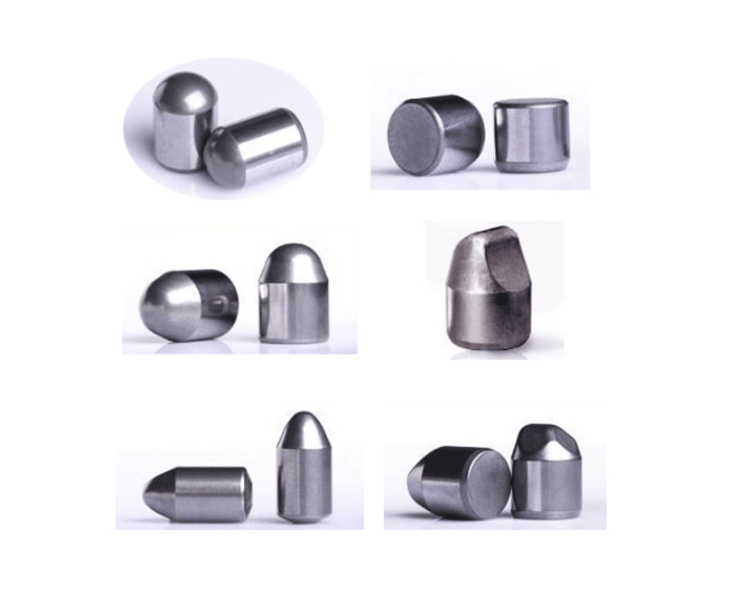
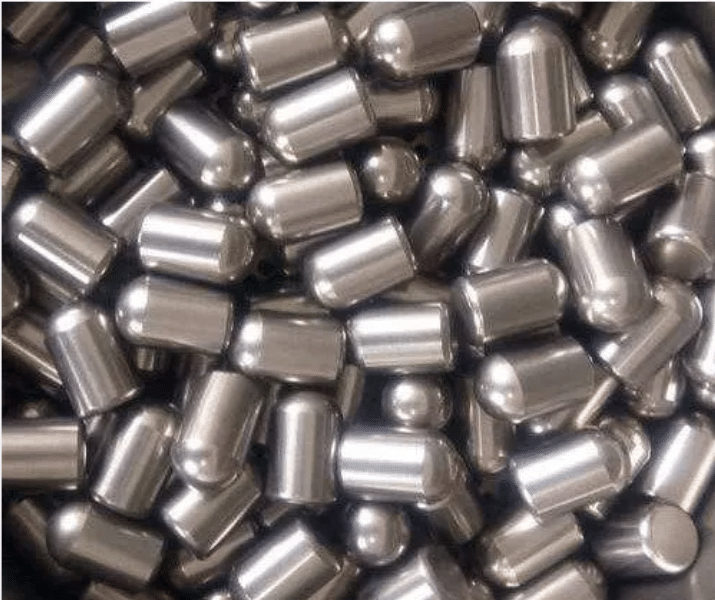
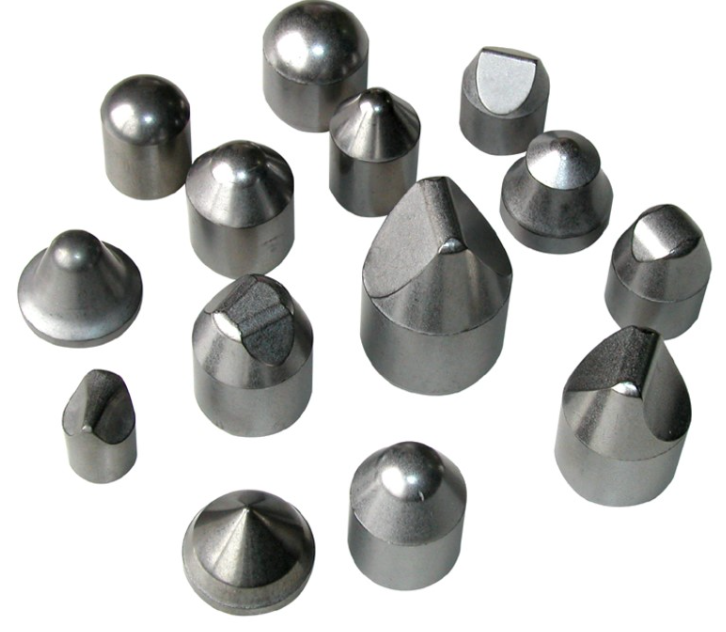
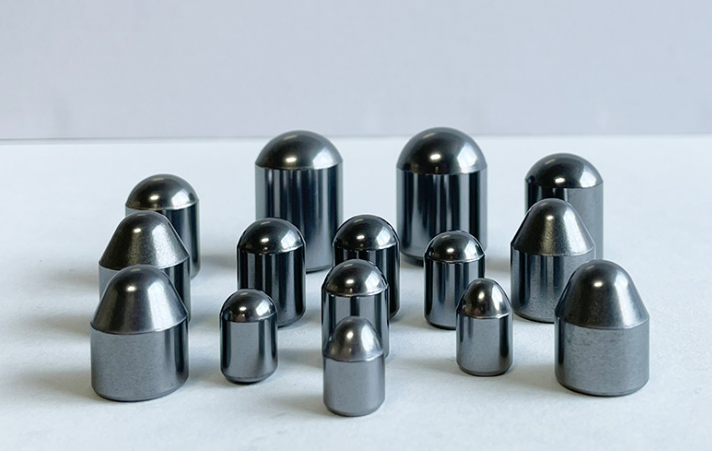
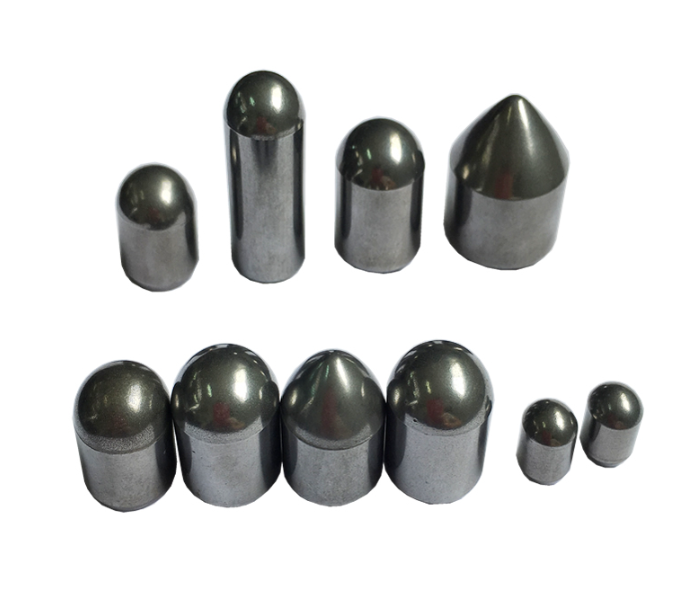
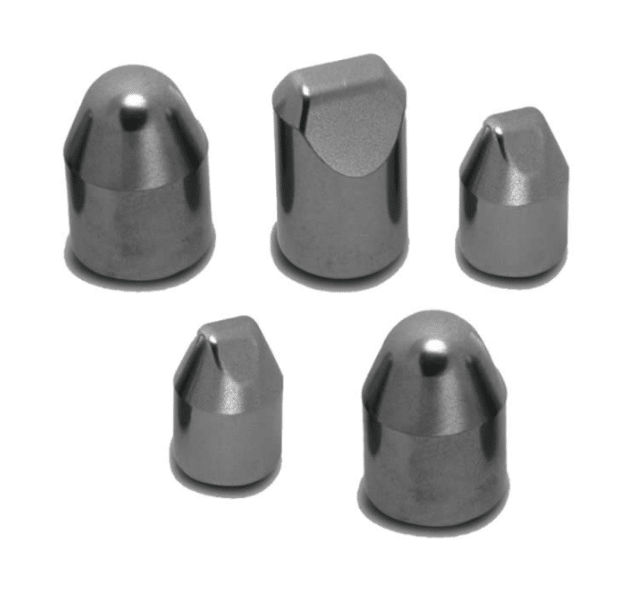
Composition, Properties, and Characteristics
The composition of carbide buttons is a mix of different powders and binders that create a material strong enough to cut through some of the hardest substances on earth. Here’s a look at some common models of carbide powder compositions used in making carbide buttons.
| Model | Composition | Properties | Characteristics |
|---|---|---|---|
| WC-6% Co | Tungsten Carbide with 6% Cobalt | High hardness, good toughness, moderate wear resistance. | Ideal for general-purpose drilling and cutting. |
| WC-10% Co | Tungsten Carbide with 10% Cobalt | Enhanced toughness, reduced hardness, high impact resistance. | Suitable for heavy-impact drilling applications. |
| WC-TiC-Co | Tungsten Carbide, Titanium Carbide, Cobalt | High wear resistance, excellent hardness. | Perfect for abrasive environments. |
| WC-5% Ni | Tungsten Carbide with 5% Nickel | Good corrosion resistance, moderate hardness. | Best for chemical processing environments. |
| WC-8% Co/2% TaC | Tungsten Carbide with 8% Cobalt and 2% Tantalum Carbide | High toughness, excellent wear resistance. | Used in high-wear industrial tools. |
| WC-12% Co | Tungsten Carbide with 12% Cobalt | Very high toughness, moderate hardness. | Optimal for extreme-impact conditions. |
| WC-CrC-Co | Tungsten Carbide, Chromium Carbide, Cobalt | Superior wear and corrosion resistance. | Great for high-corrosion environments. |
| WC-NiCr | Tungsten Carbide with Nickel-Chromium binders | Exceptional corrosion and oxidation resistance. | Suitable for aerospace and marine applications. |
| WC-6% Co/10% CrC | Tungsten Carbide with 6% Cobalt and 10% Chromium Carbide | High wear resistance, good toughness. | Ideal for high-temperature applications. |
| WC-20% TiC-Co | Tungsten Carbide with 20% Titanium Carbide and Cobalt | Ultra-high hardness, high wear resistance. | Used in specialized cutting tools for hard alloys. |
Hardness, Strength, and Wear Resistance
When it comes to carbide buttons, their ability to endure the harshest conditions is what sets them apart. Below is a table that compares hardness, strength, and wear resistance across various models.
| Model | Hardness (HRA) | Compressive Strength (MPa) | Wear Resistance (mg) |
|---|---|---|---|
| WC-6% Co | 88-90 | 3000-3200 | 0.15 |
| WC-10% Co | 85-88 | 3500-3800 | 0.18 |
| WC-TiC-Co | 92-94 | 2800-3000 | 0.10 |
| WC-5% Ni | 87-89 | 2900-3100 | 0.16 |
| WC-8% Co/2% TaC | 89-91 | 3100-3300 | 0.14 |
| WC-12% Co | 82-85 | 4000-4300 | 0.20 |
| WC-CrC-Co | 90-92 | 2950-3150 | 0.13 |
| WC-NiCr | 86-88 | 3100-3400 | 0.15 |
| WC-6% Co/10% CrC | 88-90 | 3200-3400 | 0.12 |
| WC-20% TiC-Co | 93-95 | 2700-2900 | 0.08 |
Specifications, Sizes, Shapes, and Standards
When selecting a carbide button, it’s important to understand the specifications, sizes, shapes, and standards that align with your needs. The table below breaks down these aspects to help you choose the right button for your application.
| Specification | Available Sizes (mm) | Shapes | Standards |
|---|---|---|---|
| Conical Buttons | 8-25 | Conical, pointed | ISO 9001, ANSI |
| Spherical Buttons | 10-30 | Spherical, round | ASTM, ISO |
| Chisel Buttons | 5-20 | Chisel, flat-edged | DIN, JIS |
| Parabolic Buttons | 12-28 | Parabolic, curved | ISO, ANSI |
| Flat Buttons | 15-35 | Flat, smooth | ASTM, ISO |
| Conical Parabolic | 10-25 | Hybrid conical-parabolic | DIN, ISO |
| Trapezoidal Buttons | 20-40 | Trapezoidal, wide-edged | ISO 9001, ASTM |
| Round Insert Buttons | 6-20 | Round, insert-type | ISO, JIS |
| Carbide Stud Buttons | 10-50 | Stud-like, cylindrical | ANSI, ASTM |
| Multi-pointed Buttons | 5-15 | Multi-point, precision tip | ISO, DIN |
Suppliers and Pricing Details
Finding the right supplier and understanding the pricing structure is key to making an informed purchase. Here’s a table that outlines some notable suppliers along with their pricing details.
| Supplier | Region | Pricing (per unit) | Minimum Order Quantity | Shipping Availability |
|---|---|---|---|---|
| Kennametal | North America | $2.50 – $15.00 | 100 Units | Global Shipping |
| Sandvik Coromant | Europe | $3.00 – $18.00 | 200 Units | Europe, Asia, North America |
| Zhuzhou Cemented Carbide | China | $1.50 – $12.00 | 500 Units | Asia, North America |
| Sumitomo Electric | Japan | $2.80 – $16.00 | 300 Units | Asia, Europe |
| Seco Tools | Global | $3.20 – $17.00 | 150 Units | Global Shipping |
| Tungsten Carbide USA | North America | $2.00 – $14.00 | 100 Units | North America, Europe |
| Ingersoll Cutting Tools | Europe, North America | $3.50 – $19.00 | 250 Units | Global Shipping |
| Kyocera Unimerco | Europe | $3.00 – $18.50 | 200 Units | Europe, North America |
| Iscar | Israel | $2.70 – $17.50 | 150 Units | Global Shipping |
| Carbide Depot | North America | $2.20 – $15.50 | 100 Units | North America, Europe, Asia |
How to Select the Right Carbide Button
Choosing the right carbide button can be a daunting task with so many options available. Here’s a guide to help you make the right choice based on your specific needs.
| Selection Criteria | Considerations | Recommended Carbide Button Type |
|---|---|---|
| Material Hardness | If drilling through hard materials like rock, choose a button with high hardness. | WC-TiC-Co, WC-20% TiC-Co |
| Impact Resistance | For high-impact drilling, select a button with excellent toughness. | WC-12% Co, WC-10% Co |
| Wear Resistance | In abrasive environments, opt for a button with superior wear resistance. | WC-CrC-Co, WC-6% Co/10% CrC |
| Corrosion Resistance | For chemical and corrosive environments, choose a button with good corrosion resistance. | WC-5% Ni, WC-NiCr |
| Thermal Conductivity | If operating in high-temperature environments, select a button with good thermal conductivity. | WC-TiC-Co, WC-6% Co |
| Application | Match the button type to the specific application (e.g., mining, construction). | Conical, Spherical, Chisel |
| Budget | Consider the cost-effectiveness based on your budget constraints. | Zhuzhou Cemented Carbide, Carbide Depot |
Comparing Advantages and Limitations
No material is perfect for every application. Here’s a comparison of the advantages and limitations of different carbide button models.
| Model | Advantages | Limitations |
|---|---|---|
| WC-6% Co | Good balance of hardness and toughness, cost-effective. | May wear faster in very abrasive conditions. |
| WC-10% Co | High toughness, ideal for impact applications. | Slightly reduced hardness compared to lower cobalt content models. |
| WC-TiC-Co | Exceptional hardness, great for abrasive environments. | Lower impact resistance, higher cost. |
| WC-5% Ni | Good corrosion resistance, moderate hardness. | Not as tough as cobalt-bound carbide. |
| WC-8% Co/2% TaC | Excellent wear resistance, good toughness. | Higher cost due to tantalum content. |
| WC-12% Co | Extremely tough, ideal for heavy-duty applications. | Reduced hardness, may deform under extreme pressure. |
| WC-CrC-Co | Superior wear and corrosion resistance. | Higher cost, may not be necessary for non-corrosive environments. |
| WC-NiCr | Exceptional corrosion resistance, good for marine applications. | May not perform as well in high-impact applications. |
| WC-6% Co/10% CrC | Excellent wear resistance, good for high-temperature applications. | Higher cost, lower toughness. |
| WC-20% TiC-Co | Ultra-high hardness, great for cutting hard alloys. | Lower toughness, higher cost. |

FAQs
What is a carbide button made of?
Carbide buttons are primarily made from tungsten carbide, a compound that includes tungsten and carbon. Some models may include other elements like cobalt, nickel, titanium, or chromium to enhance specific properties such as toughness, wear resistance, or corrosion resistance.
How do I choose the right carbide button?
Consider factors like material hardness, impact resistance, wear resistance, corrosion resistance, and the specific application you’re targeting. The type of material you’re drilling or cutting, along with your budget, will also play a significant role in your decision.
Can carbide buttons be customized?
Yes, many manufacturers offer customization options for carbide buttons, allowing you to specify the size, shape, composition, and other parameters to suit your specific needs. Custom buttons may.
What industries use carbide buttons the most?
Carbide buttons are widely used in industries such as mining, construction, metalworking, oil and gas exploration, aerospace, automotive manufacturing, and renewable energy. These industries rely on carbide buttons for their high durability, hardness, and ability to perform under extreme conditions.
How does the composition of a carbide button affect its performance?
The composition of a carbide button, including the type and percentage of binders like cobalt or nickel, significantly affects its hardness, toughness, wear resistance, and corrosion resistance. For example, higher cobalt content generally increases toughness but decreases hardness, while adding elements like titanium carbide can improve wear resistance at the cost of some toughness.
Where can I buy carbide buttons?
Carbide buttons can be purchased from a variety of suppliers, including specialized tool manufacturers, industrial equipment providers, and online marketplaces. Leading suppliers include Kennametal, Sandvik Coromant, and Zhuzhou Cemented Carbide, among others. Be sure to consider factors like pricing, shipping availability, and minimum order quantities when making your purchase.




